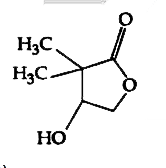Isobutyraldehyde on reaction with formaldehyde and K2CO3, gives compound 'A'. Compound "A' reacts with KCN and yields compound 'B', which on hydrolysis gives a stable compound 'C'. The compound 'C' is
HO−CH2−CH3∣C∣CH3−CH∣OH−COOH
HO−CH2CH2−CH∣CH3−CH∣OH−COOH


The correct Answer is:C
To solve the problem step by step, we will analyze the reactions involving isobutyraldehyde, formaldehyde, K2CO3, KCN, and the hydrolysis process to find the stable compound 'C'.
Step 1: Reaction of Isobutyraldehyde with Formaldehyde
Isobutyraldehyde (CH3)2C=CHOH reacts with formaldehyde (HCHO) in the presence of K2CO3 (a base). This reaction is a typical example of an aldol condensation, where two aldehydes react to form a β-hydroxy aldehyde.
The reaction can be represented as follows:
- Isobutyraldehyde + Formaldehyde → Compound A
The structure of Compound A will be:
- Compound A: (CH3)2C(OH)CH2CHO
Step 2: Reaction of Compound A with KCN
Next, Compound A reacts with KCN (potassium cyanide). This reaction typically involves nucleophilic addition of the cyanide ion (CN-) to the carbonyl group of Compound A, leading to the formation of a cyanohydrin.
The reaction can be represented as follows:
- Compound A + KCN → Compound B
The structure of Compound B will be:
- Compound B: (CH3)2C(OH)CH(CN)OH
Step 3: Hydrolysis of Compound B
Now, Compound B undergoes hydrolysis. In this step, the cyanide group (CN) is converted to a carboxylic acid (COOH) through hydrolysis.
The reaction can be represented as follows:
- Compound B + H2O → Compound C
The structure of Compound C will be:
- Compound C: (CH3)2C(OH)COOH
Step 4: Stability of Compound C
Compound C is stable due to the presence of the carboxylic acid group and the hydroxyl group, which can form intramolecular hydrogen bonds, contributing to its stability.
Final Answer
The stable compound 'C' is:
- Compound C: 2-Hydroxy-4-methylpentanoic acid (or 2-hydroxy-3-methylbutanoic acid)
---
Isobutyraldehyde (CH3)2C=CHOH reacts with formaldehyde (HCHO) in the presence of K2CO3 (a base). This reaction is a typical example of an aldol condensation, where two aldehydes react to form a β-hydroxy aldehyde.
- Isobutyraldehyde + Formaldehyde → Compound A
- Compound A: (CH3)2C(OH)CH2CHO
Next, Compound A reacts with KCN (potassium cyanide). This reaction typically involves nucleophilic addition of the cyanide ion (CN-) to the carbonyl group of Compound A, leading to the formation of a cyanohydrin.
- Compound A + KCN → Compound B
- Compound B: (CH3)2C(OH)CH(CN)OH
Now, Compound B undergoes hydrolysis. In this step, the cyanide group (CN) is converted to a carboxylic acid (COOH) through hydrolysis.
- Compound B + H2O → Compound C
- Compound C: (CH3)2C(OH)COOH
Compound C is stable due to the presence of the carboxylic acid group and the hydroxyl group, which can form intramolecular hydrogen bonds, contributing to its stability.
The stable compound 'C' is:
- Compound C: 2-Hydroxy-4-methylpentanoic acid (or 2-hydroxy-3-methylbutanoic acid)
Similar Questions
An organic compound 'A' having molecular formula C4H10O does not react with sodium metal. On hydrolysis with dilute H2SO4 It gives only one organic compound 'B' . The compound B on heating with red phosphours and iodine gives compound 'C'. The compound C can also be obtained from compound 'A' on heating with excess HI. Identify the compounds A, B and C.
View SolutionCompound 'A' on chlorination gives compound 'B', compound 'B' reacts with alc. KOH gives gas 'C', which decolourise Baeyer reagent. Ozonolysis of compound 'C' gives only HCHO compound 'A' is:
View Solution
Knowledge Check
The following compound on hydrolysis will give
 AA pair of anomersBA pair of enantiomerisCA pair of epimersDA pair of molecules having common tautomer
AA pair of anomersBA pair of enantiomerisCA pair of epimersDA pair of molecules having common tautomerWhich compound reacted with CO2 gives an organic compound?
AH2OBNH3CCl2DPCl5Compound A is reacted with KCN and followed by reduction using SnCl2+HCl and successive hydrolysis gives propanal. The compound A is
AC2H5−XBC2H5−OHCCH3−CH2−CH2−XDC2H5−CN
A compound 'Z' reacts with three moles of CH3I and gives a product which on hydrolysis gives [(CH3)4N]+OH−. Compound 'Z' is
View SolutionA compound Z' reacts with three moles of CH3I and gives a product which on hydrolysis gives [(CH3)4N]+OH−. Compound 'Z' is
View SolutionCompound A on reduction gives B which on further reaction with CHCl3 and alcoholic KOH gives compound C which of further hydrolysis gives aniline. The compound A is :
View SolutionPropyl lithium reacts with ethene to give a compound (A), which on reaction with methanal followed by acidic hydrolysis gives compound (B). The compound (B) is :
View SolutionAn organic compound A reacts with PCl5 to give compound B. Compound B reacts with Na/ether to give n-butane. What are compounds A and B ?
View Solution
